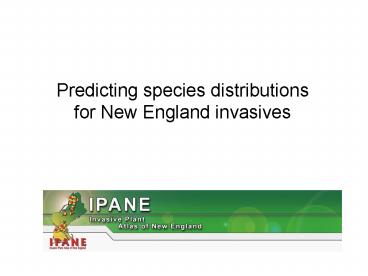Predicting species distributions for New England invasives PowerPoint PPT Presentation
1 / 23
Title: Predicting species distributions for New England invasives
1
Predicting species distributions for New England
invasives
2
(No Transcript)
3
(No Transcript)
4
- Explanatory data layers
- Field collected information
habitat/community type, canopy closure,
slope aspect, soil moisture regime - Climate variables Mean annual precipitation,
Mean annual snow fall, Mean annual min max
temperatures, Annual record extreme min max
temperature, Mean annual temperature, Mean length
of frost free period, Mean number of growing
degree days, Mean annual number of heating
degree days 2 km grid scale. - Topographic variables DEM - average elevation
for 2km grid cell, DEM
range, high and low values for 2km
grid cell. - Road influences Distance to Road (for each
IPANE plot point), Length of Roads within
each 2km grid cell. - Landuse landcover percent land cover of
each of 9 classes resampled from 30m
resolution to 2 km.
5
IPANE data are used for predictive modeling.
Here is the predicted spread of Celastrus
orbiculatus (from dark areas to light areas) in
New England.
The uncertainty (variance) is also measured in
the predictive model (darker areas are most
uncertain).
Celastrus orbiculatus Oriental bittersweet
Example of modeled invasive distribution at the
regional scale Oriental bittersweet
6
Local to landscape patterns
7
C. orbiculatus 251 out of 603 - 41.6
8
Is there an effects of land-use or land-use
change on the distribution of invasive species in
the New England landscape?
9
Land-use change in a local landscape
10
Quantifying land-use change in the landscape over
the past 70 years from aerial photography in
Connecticut
2000
1970
1951
1934
11
Procedure
- Process historical aerial photographs create
geo-corrected mosaic images of 5 different time
periods. - Digitize land use features - visual
interpretation of aerial mosaics using a suite of
LULC categories. - Create a stratified random sampling scheme -
Generate 50 random points for each change
category. - Sampling - based upon the IPANE plot protocols
12
Digitizing Example
13
LULC Change Categories
1. Forest - No Change 2. Cultivated Fields - No
change 3. Pasture/Meadow - No change 4.
Residential/Commercial - No change 5. Abandoned
fields to Forest 6. Cultivated fields to
Forest 7. Pasture/Meadow to Forest 8.
Cultivated Fields to Abandoned to Forest 9.
Pasture/Meadow to Abandoned to Forest 10.
Cultivated fields to Abandoned fields 11.
Pasture/Meadow to Abandoned fields 12. Forest
to Residential/Commercial 13. Cultivated fields
to Residential/Commercial 14. Pasture to
Residential/Commercial 15. Abandoned fields to
Residential/Commercial 16. Abandoned fields to
Forest to Residential/Commercial
No Change
Agricultural Fields Reverted to Forest
Abandoned Fields as of 2003
Conversion to Residential/ Commercial
14
Final Plot Points
603 in Total 507 Random, 96 Opportunistic
15
Presence of One or More Invasive Species
All Plots 363 / 603 or 60.2
Random Plots 288 / 507 or 55.4
16
C. orbiculatus 251 out of 603 - 41.6
Random 186 / 507 36.7
1000 3 100 - 999 53 20 - 99 100
17
B. thunbergii 199 out of 603 - 33.0
Random 140 / 507 27.6
1000 2 100 - 999 31 20 - 99 47
18
Presence/AbsenceIndividual Species by LULC
Groups(From Random Plots N 507)
19
Hierarchy of Invasion ( Abundance of all species
combined)
1st Abandoned Fields as of 2003 (p
.005) 2nd Agricultural Fields Reverted to
Forest (p lt .0001) 3rd Conversion to
Residential / Commercial (p lt .0001) 4th
Categories with No Change
20
Regression models
Invasive species abundance f(environmental
explanatory variables)
Explanatory variables Community type (24
IPANE categories), Habitat class (4), Canopy
closure, Slope aspect, Soil moisture, LULC
(12 or 5), Distance to Road, Road density,
Distance to nearest building, Building density,
Edge Distance (and type), Elevation,
Geology, Soil type and Soil drainage class.
21
Explaining spatial patterns in Oriental
bittersweet abundance using regression models
Community type Aspen/birch, old fields,
forest/field edge, roadsides. - Oak/pine
forests. LULC type conversion to
residental/commercial, abandoned fields,
fields reverting to forest. - agricultural
fields, no change, especially forest. Canopy
closure - moderate to dense canopies Edge
distance - Minor contribution soils, building
distance, prior vegetation cover
22
Explaining spatial patterns in Japanese barberry
abundance using regression models
Canopy closure - for densest canopy
closure Community type upland red maple,
northern hardwoods, birch/aspen, old
fields, open fields - agricultural fields,
coniferous forests, oak/pine forests. LULC
field reverting to forests - agricultural
fields, forests Edge distance -
23
Mid-Spring ADARA Possible Remote Sensing
Search Tool for Invasives?

